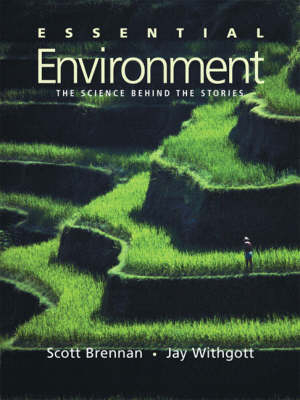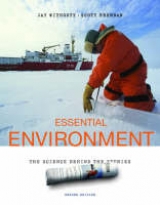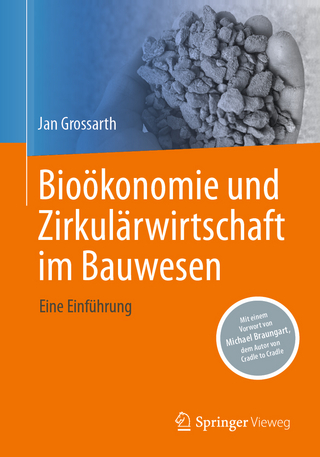
Essential Environment
Pearson Education (US) (Verlag)
978-0-8053-4487-5 (ISBN)
- Titel erscheint in neuer Auflage
- Artikel merken
Essential Environment: The Science behind the Stories is an introductory textbook that uses case studies and real data to demonstrate the role of science in solving pressing environmental problems. Dynamic central case studies are integrated throughout each chapter, capturing students' attention and providing them with a contextual framework on which to build their understanding of concepts in environmental science.
Science Behind the Story boxes explain how scientists know what they know about environmental problems, while opposing viewpoints on contentious environmental issues allow students to hear both sides of the story. The powerful instructor presentation package includes 5-minute video clips for use as lecture launchers and lecture outlines in PowerPoint. The student CD-Rom and website includes GRAPH-IT graphing tutorials which show students how to plot, interpret, and critically evaluate real data.
With only 14 chapters, Essential Environment: The Science behind the Stories avoids the encyclopedic approach of other textbooks on the market and instead offers only the essential concepts, theories, and principles of environmental science. In particular, the authors have condensed the material on environmental policy, agriculture, atmosphere, and water, providing the student with the essential material they need in a more concise, affordable format.
Scott Brennan teaches environmental science, policy, and journalism at Western Washington University's Huxley College of the Environment. He has also worked as a journalist, policy analyst, and environmental consultant. The recipient of a Duke University research fellowship in marine science, Brennan's accomplishments have been recognized by Washington State University, Western Washington University, and the Society of Professional Journalists. Jay Withgott is a science and environmental writer, and has written for a variety of journals and magazines including Science, New Scientist,Current Biology, Conservation in Practice, and Natural History. Holding an undergraduate degree in History and Studies in the Environment atYale University, Withgott has authored nearly 20 scientific research papers and has taught labs in Ecology and other subjects while gaining masters degrees in Biological Sciences (University of Arkansas) and Ecology and Evolutionary Biology (University of Arizona).
I. FOUNDATIONS OF ENVIRONMENTAL SCIENCE.
1. An Introduction to Environmental Science.
Our Island, Earth.
The Nature of Environmental Science.
The Nature of Science.
Worldviews and Environmental Ethics.
2. Environmental Economics and Environmental Policy.
Central Case Study: San Diego and Tijuana's Sewage Pollution Problems and Policy Solutions.
Economic Approaches.
Economics and Environmental Implications.
An Overview of Environmental Policy.
U.S. Environmental Policy.
The Environmental Policy Process.
International Environmental Policy.
3. Environmental Systems: Chemistry, Energy, and Ecosystems.
Central Case Study: The Gulf of Mexico's “Dead Zone”.
Environmental Systems.
Chemistry and the Environment.
Energy Fundamentals.
Biomes.
Earth's Environmental Cycles.
4. Ecology and Evolution: Populations, Communities, and Biodiversity.
Central Case Study: Striking Gold in a Costa Rican Cloud Forest.
Evolution by Natural Selection.
Evolution as the Wellspring of Earth's Biodiversity.
Units of Ecological Organization.
Population Ecology.
Community Ecology.
II. ENVIRONMENTAL PROBLEMS AND THE SEARCH FOR SOLUTIONS.
5. Human Population Growth.
Central Case Study: China's One Child Policy.
Overview of Human Population Growth.
Demography.
Population and Society.
6. Soils, Agriculture, and the Future of Food.
Central Case Study: No-till Agriculture in Southern Brazil.
The Science of Soil.
Soil Degradation and Conservation.
Feeding a Growing Human Population.
Pest Management.
Biotechnology and the Future of Food.
7. Toxicology and Environmental Health.
Central Case Study: Alligators and Endocrine Disruptors at Lake Apopka, Florida.
Toxic Agents in the Environment.
Studying the Effects of Toxicants.
Environmental Health Hazards.
Risk Assessment and Risk Management.
Philosophical Approaches and Policy.
8. The Atmosphere, Air Pollution, and Global Climate Change.
Central Case Study: Rising Temperature and Seas May Take the Maldives Under.
Atmospheric Science.
Outdoor Air Pollution.
Indoor Air Pollution.
Global Climate Change.
Studying Climate Change.
Climate Change Estimates and Predictions.
Strategies for Emissions Reduction.
9. Freshwater and Marine Resources.
Central Case Study: Plumbing the Colorado River.
Freshwater Systems.
Use and Depletion of Freshwater.
Pollution of Freshwater.
Marine Systems.
Use and Impacts: Emptying the Oceans.
Marine Conservation Biology.
10. Biodiversity and Conservation Biology.
Central Case Study: Saving the Siberian Tiger.
Our Planet of Life.
Biodiversity Loss and Species Extinction.
Benefits of Biodiversity.
Conservation Biology.
11. Land Use, Forest Management, and Creating Livable Cities.
Central Case Study: The Chicago-Area Forest Preserve System.
Our Urbanizing World.
Forestry, Land Use, and Resource Management.
Parks, Reserves, and Wildlands.
Creating Livable Cities.
12. Nonrenewable Energy Sources and Their Environmental Impacts.
Central Case Study: Oil or Wilderness on Alaska's North Slope?
Sources of Energy.
Fossil Fuels.
Environmental Impacts of Fossil Fuel Use.
Political, Social, and Economic Impacts of Fossil Fuel Use.
Nuclear Power.
Energy Conservation.
13. Renewable Energy Sources.
Central Case Study: Iceland Moves toward a Hydrogen Economy.
Biomass.
Hydroelectric Power.
Solar Energy.
Wind Energy.
Geothermal Energy.
Ocean Energy Sources.
Hydrogen.
14. Waste Management.
Central Case Study: Dump-Dwellers and Manila's Garbage Crisis.
Types of Waste.
Municipal Solid Waste.
Industrial Solid Waste.
Hazardous Waste.
Wastewater and Sewage Treatment.
Epilogue: Sustainable Solutions.
Appendix A: Periodic Table of the Elements.
Appendix B: The Metric System.
Glossary.
References.
Credits.
Index.
| Erscheint lt. Verlag | 14.4.2005 |
|---|---|
| Verlagsort | Upper Saddle River |
| Sprache | englisch |
| Gewicht | 902 g |
| Themenwelt | Naturwissenschaften ► Biologie ► Ökologie / Naturschutz |
| ISBN-10 | 0-8053-4487-X / 080534487X |
| ISBN-13 | 978-0-8053-4487-5 / 9780805344875 |
| Zustand | Neuware |
| Haben Sie eine Frage zum Produkt? |
aus dem Bereich



